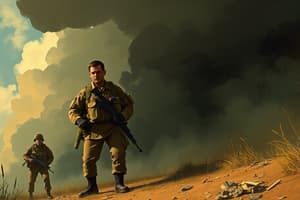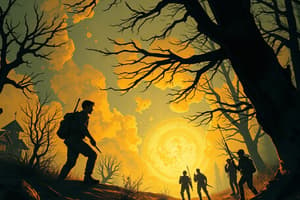Podcast
Questions and Answers
What does Lieutenant Jimmy Cross carry with him?
What does Lieutenant Jimmy Cross carry with him?
- A letter from Martha (correct)
- A stone (correct)
- A photo of his family
- A book
What does O'Brien use to show the soldiers' personalities?
What does O'Brien use to show the soldiers' personalities?
The items they carry
Jimmy Cross and Martha eventually get married.
Jimmy Cross and Martha eventually get married.
False (B)
What does O'Brien want to write a story about?
What does O'Brien want to write a story about?
What prompts O'Brien to not run away from the war?
What prompts O'Brien to not run away from the war?
Elroy Berdahl helps O'Brien realize he wants to go to war.
Elroy Berdahl helps O'Brien realize he wants to go to war.
What do Jensen and Strunk agree on regarding their injuries?
What do Jensen and Strunk agree on regarding their injuries?
What superstitious item does Henry Dobbins carry?
What superstitious item does Henry Dobbins carry?
Who dies in the story 'How to Tell a True War Story'?
Who dies in the story 'How to Tell a True War Story'?
Tim O'Brien reflects on his experiences of the Vietnam War while talking about his first love, _____ who died from a brain tumor.
Tim O'Brien reflects on his experiences of the Vietnam War while talking about his first love, _____ who died from a brain tumor.
O'Brien believes that story truth is sometimes more meaningful than happening truth.
O'Brien believes that story truth is sometimes more meaningful than happening truth.
What does Norman Bowker struggle to communicate?
What does Norman Bowker struggle to communicate?
How do the soldiers try to cope with the death of their comrades?
How do the soldiers try to cope with the death of their comrades?
Study Notes
Chapter 1: "The Things They Carried"
- Lieutenant Jimmy Cross carries a letter and pebble from his love, Martha; represents emotional connection.
- Introduction of soldiers and their burdens highlights both physical and emotional weights they bear.
- Lavender's death, caused by Cross's distraction, leads to Cross's vow to sever his thoughts of Martha.
Chapter 1: Analysis
- Items carried symbolize soldiers’ personalities and emotional burdens.
- Cross and Martha embody themes of love intertwined with the horror of war.
Chapter 2: "Love"
- Cross reflects on conversations with O'Brien about his relationship with Martha.
- Reunion triggers memories, revealing Martha as a Lutheran missionary who later gives Cross another photo.
Chapter 3: "Spin"
- O'Brien emphasizes that war encompasses moments of levity alongside horror.
- Recollections include years of trivial events, revealing the absurdity amidst the violence of combat.
Chapter 4: "On the Rainy River"
- O'Brien describes receiving his draft notice and grappling with moral conflict about participating in the Vietnam War.
- A transformative encounter with Elroy Berdahl at the Rainy River offers O'Brien a glimpse of freedom.
- O'Brien ultimately chooses to go to war to avoid the shame of evasion.
Chapter 4: Analysis
- Explores the moral challenges and guilt associated with war.
- Elroy symbolizes the choice for freedom, contrasting O'Brien's decision to conform.
Chapter 5: "Enemies"
- Tension escalates between soldiers Dave Jensen and Lee Strunk over a stolen knife.
- Illustrates how war-induced stress leads to violent behavior among comrades.
Chapter 6: "Friends"
- Jensen and Strunk build trust, agreeing on a pact regarding the treatment of serious injuries.
- Strunk's amputation and pleas against mercy killing emphasize the strain of their agreement.
Chapter 7: "How to Tell a True War Story"
- The chapter centers on the impactful death of Kurt Lemon and Rat Kiley's reaction, showcasing profound grief.
Chapter 8: "The Dentist"
- Curt Lemon's irrational fear of the dentist results in a self-destructive act to confront it.
- Highlights themes of masculinity and overcoming fear.
Chapter 9: "Sweetheart of the Song Tra Bong"
- Mary Anne Bell’s transformation from naive to fierce warrior exemplifies changing perceptions in war.
- Rat Kiley’s fictional ending reflects the haunting impact of war narratives.
Chapter 10: "Stockings"
- Henry Dobbins wears his girlfriend's pantyhose as a talisman, showcasing superstition's role in soldier psychology.
- Despite his girlfriend's departure, Dobbins maintains belief in its protective power.
Chapter 11: "Church"
- The soldiers’ encounter with monks highlights interaction with spirituality amidst violence.
- Dobbins expresses an affinity for community despite his lack of religious beliefs.
Chapter 12: "The Man I Killed"
- O'Brien reflects on a man's death, crafting a narrative around the victim’s potential life and struggles.
Chapter 13: "Ambush"
- O’Brien's confession of killing a boy 20 years later illustrates the ongoing burden of guilt and memory.
Chapter 14: "Style"
- A Vietnamese girl dances amidst destruction, evoking differing interpretations of trauma among soldiers.
- Azar's mockery of the girl's dance elicits camaraderie and conflict within the platoon.
Chapter 15: "Speaking of Courage"
- Norman Bowker's introspection on courage and unfulfilled expectations highlights post-war alienation.
- He struggles to share his experiences, reflecting on his life’s purpose.
Chapter 16: "Notes"
- Bowker’s suicide underscores the lasting scars of war and its impact on mental health.
- He urges O’Brien to capture the struggle for meaning post-Vietnam.
Chapter 17: "In the Field"
- Kiowa’s death in waste symbolizes the loss of innocence and the harsh realities of war.
- Cross's regret over the campsite decision reinforces feelings of guilt.
Chapter 18: "Good Form"
- O'Brien differentiates between "real truth" and "story truth," emphasizing the emotional resonance of war stories.
- His reflections on memory reveal the complexities of recounting traumatic experiences.
Chapter 19: "Field Trip"
- O’Brien revisits Kiowa's death site with his daughter, highlighting generational disconnect regarding war experiences.
- The journey portrays a blend of nostalgia and the enduring weight of traumatic memories.
Chapter 20: "The Ghost Soldiers"
- O’Brien recounts two separate injuries, contrasting the abilities of medics Kiley and Jorgenson.
- Revenge against Jorgensen reveals themes of vulnerability and camaraderie in horror.
Chapter 21: "Night Life"
- The platoon’s nighttime operations amplify existing fears and create a haunted atmosphere.
- Rat Kiley’s self-inflicted injury represents the psychological toll of constant stress.
Chapter 22: "The Lives of the Dead"
- O’Brien reminisces about his childhood love, Linda, and the realities of death.
- Stories serve as a means to keep memories alive, bridging past and present experiences of loss.
Studying That Suits You
Use AI to generate personalized quizzes and flashcards to suit your learning preferences.
Description
This flashcard quiz covers Chapter 1 of 'The Things They Carried' by Tim O'Brien. It discusses Lieutenant Jimmy Cross's emotional struggles and the burdens both physical and emotional that the soldiers carry during the Vietnam War. Explore themes of love, guilt, and the realities of war as conveyed through Cross's experiences.




